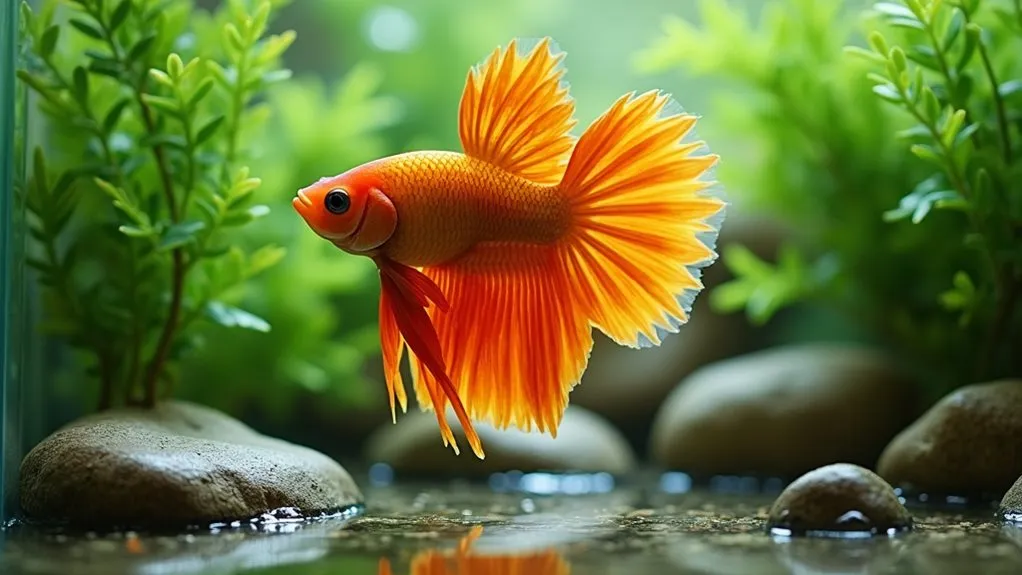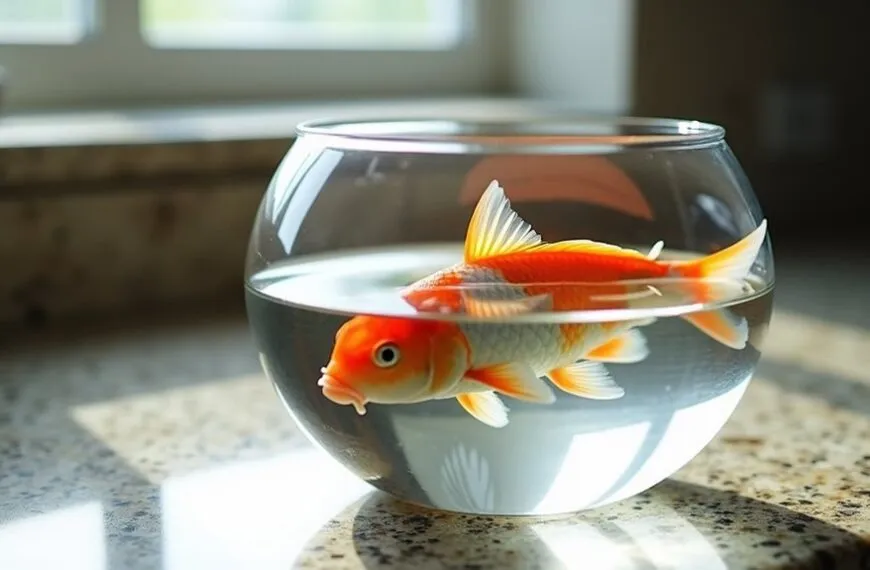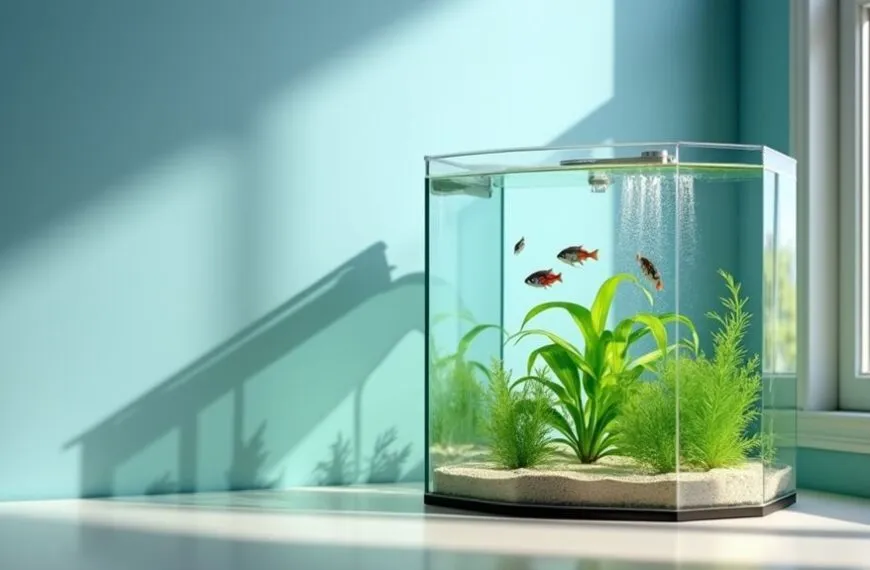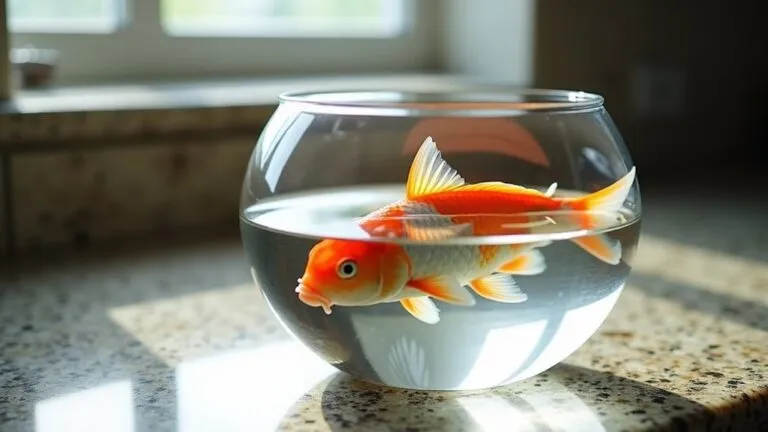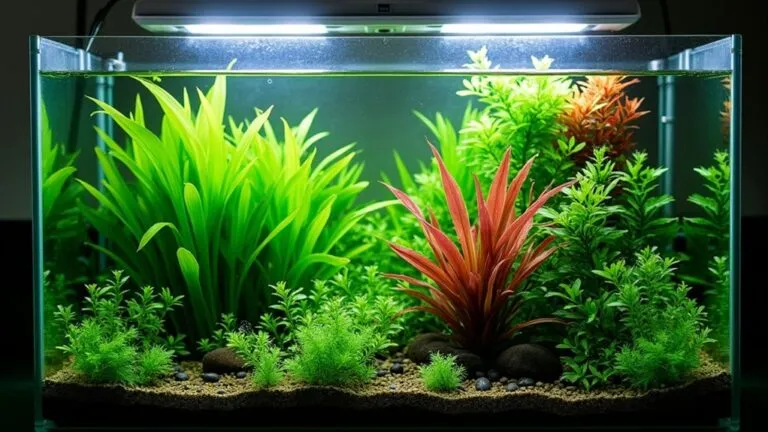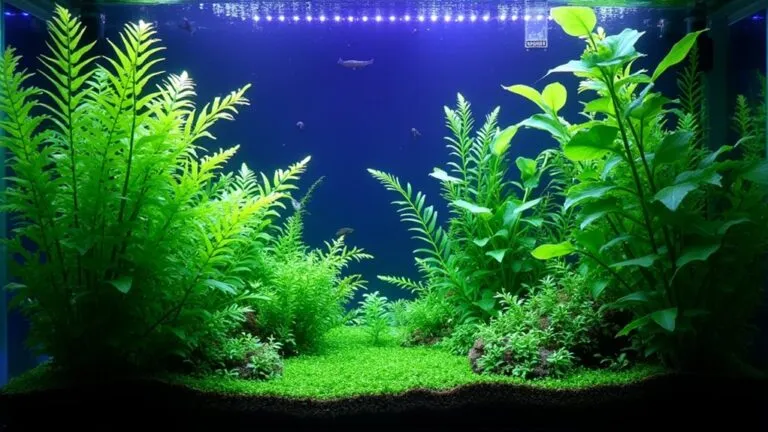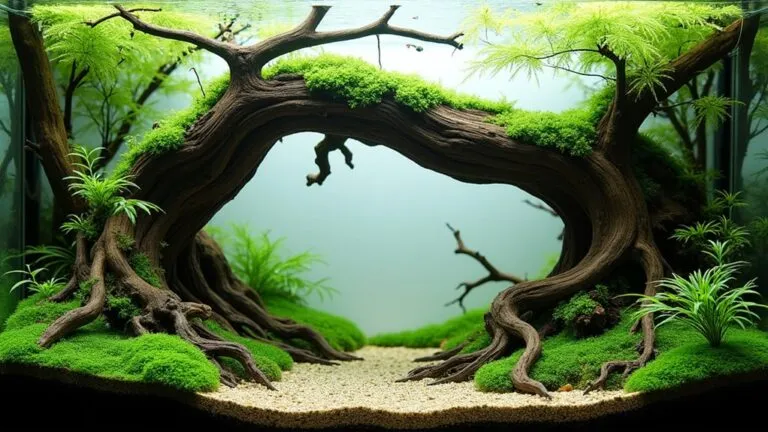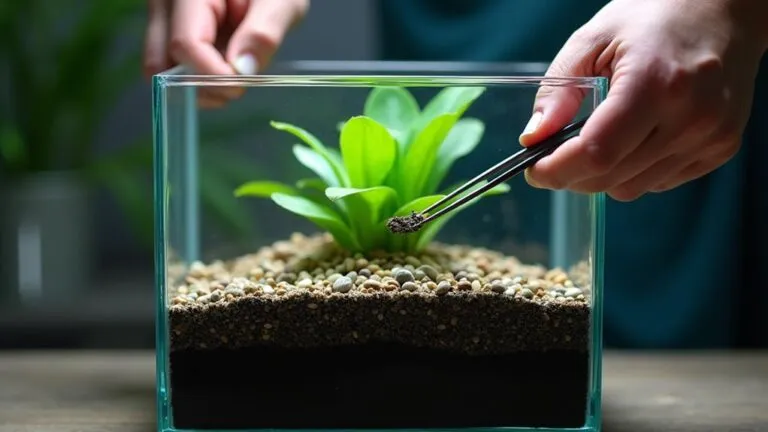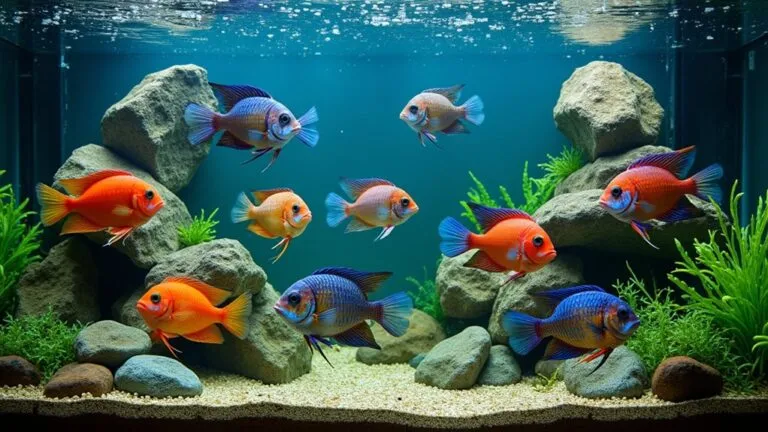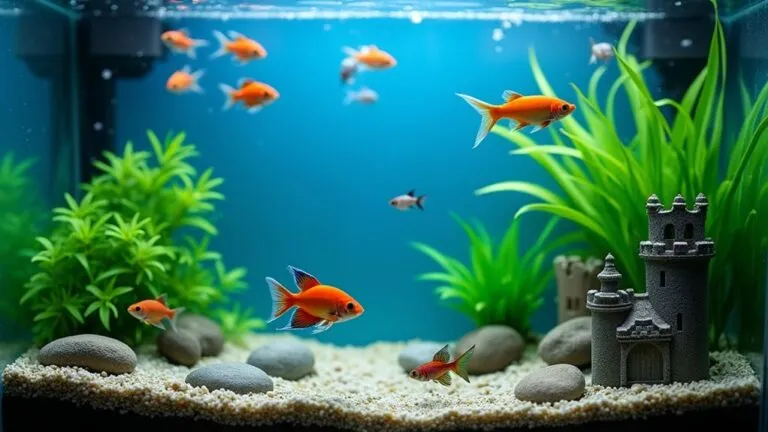If you're looking for a low-maintenance aquatic friend, you can't go wrong with Betta fish or guppies. These hardy swimmers are perfect for beginners, thriving in smaller tanks and adapting well to various water conditions. Bettas, known for their stunning fins and independent personalities, can live happily in tanks as small as 5 gallons, while guppies bring vibrant colors and social charm to your aquarium. Both species are resilient, easy to feed, and forgiving of minor care mistakes that newcomers might make. With basic tank maintenance and regular feeding, these fish can live for years – and there's so much more to discover about making them truly flourish.
Contents
Choosing Your First Fish
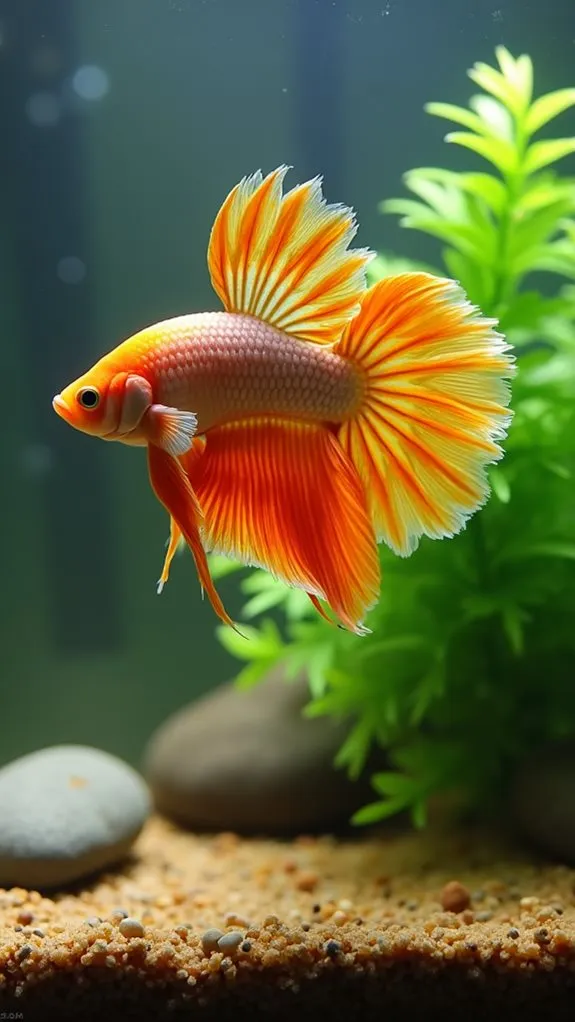
When it comes to selecting your first fish, choosing a hardy and peaceful species will set you up for success. For your first aquarium, you'll want to take into account fish that are both resilient and easy to care for, making species like guppies and platies excellent choices.
These colorful little swimmers aren't just pretty to look at – they're also incredibly forgiving of minor maintenance mishaps that might occur while you're learning the ropes. Guppies show great adaptability as they can thrive in various water conditions. A small aquarium setup is perfect for beginners since it requires less maintenance and fewer water changes. Additionally, keeping your aquarium well-planted supports optimal tank conditions that benefit the fish.
If you're feeling a bit nervous about choosing fish for the first time, think about starting with White Cloud Mountain Minnows or Corydoras Catfish.
They're like the golden retrievers of the fish world – friendly, adaptable, and nearly impossible to ruffle! These species can handle varying water conditions and won't give you a headache with complex care requirements.
Just remember to get a proper filter and maintain stable water parameters, and they'll reward you with years of entertainment.
For an added bonus, these beginner-friendly fish are typically social creatures, so you can keep them in small groups and watch them interact with each other, creating a lively and engaging display in your new aquatic home.
Meet The Betta Fish
If you're looking for a stunning first fish that won't need a mansion-sized tank, you'll love the beautiful betta fish.
These vibrant swimmers pack a lot of personality into a small package and can thrive in tanks as modest as 5 gallons, making them perfect for apartments or desktop setups. Adding natural live plants to their habitat helps create a more engaging and stimulating environment for these curious fish and can significantly improve water quality as well.
While they're often marketed as "easy care" fish, you'll need to provide them with the right environment and attention – but don't worry, their basic needs aren't complicated to meet. With proper care and maintenance, your betta can be a companion for 5 to 7 years.
Perfect For Small Tanks
For beginners seeking an easy-to-maintain fish, the betta fish stands out as an excellent choice for small tanks. When planning your betta setup, you'll need at least a 2.5-gallon tank, though a 5-gallon tank is much better for your finned friend's happiness and health. Regular water testing will help ensure your betta stays healthy by monitoring pH and ammonia levels. While bettas can survive in smaller spaces, proper tank size is crucial for preventing stress and illness. It's also important to keep in mind that bettas are territorial fish, which means they shouldn't be housed with more aggressive species.
Tank filtration becomes easier with larger tanks, and you won't have to change the water as frequently.
You'll love how adaptable bettas are to different spaces, but don't fall for the old fish bowl trick! Your betta needs a proper tank with a secure lid (these little athletes can jump!), and they prefer longer, shallower tanks that mirror their natural habitat.
Make sure you're keeping the water temperature between 76 and 81 degrees Fahrenheit – your betta will thank you by showing off those gorgeous fins!
If you're setting up a tank in your bedroom or office, you'll appreciate that male bettas need to live solo – they're the divas of the fish world!
Just give them some betta-safe decorations for hiding spots, maintain proper water quality, and you'll have a thriving underwater companion who's full of personality.
Low Maintenance Beauty
The betta fish proves itself as one of the most stunning yet low-maintenance aquarium pets you'll ever own. With their beautiful colors and flowing fins, these aquatic jewels don't demand constant attention like some other fish species. These captivating fish originated from muddy ponds in Thailand, where they developed their hardiness and adaptability. You'll need to maintain the temperature between 78-82 degrees Fahrenheit for optimal betta health, as they prefer stable water conditions to thrive with minimal fluctuations.
You'll find that caring for your betta is surprisingly straightforward, especially when you've got the basics down.
Here's why bettas are perfect for both new and experienced fish keepers:
- Simple feeding schedule – Just feed them once or twice daily, with a weekly fasting day that's perfect for busy pet parents.
- Minimal space requirements – A single betta thrives in a 5-gallon tank, making them ideal for apartments or small spaces.
- Basic maintenance needs – Weekly water changes of just 15-25% keep your low maintenance friend happy and healthy.
Your betta's vibrant personality shines through without requiring complicated care routines.
While they'll need a heater and filter, these are set-and-forget items that need minimal adjustment. Plus, you won't have to worry about constant tank cleaning or complex feeding schedules.
Just remember to use water conditioner when doing water changes, and you'll have a beautiful, thriving companion that brings life to your space.
Guppies Are Natural Swimmers
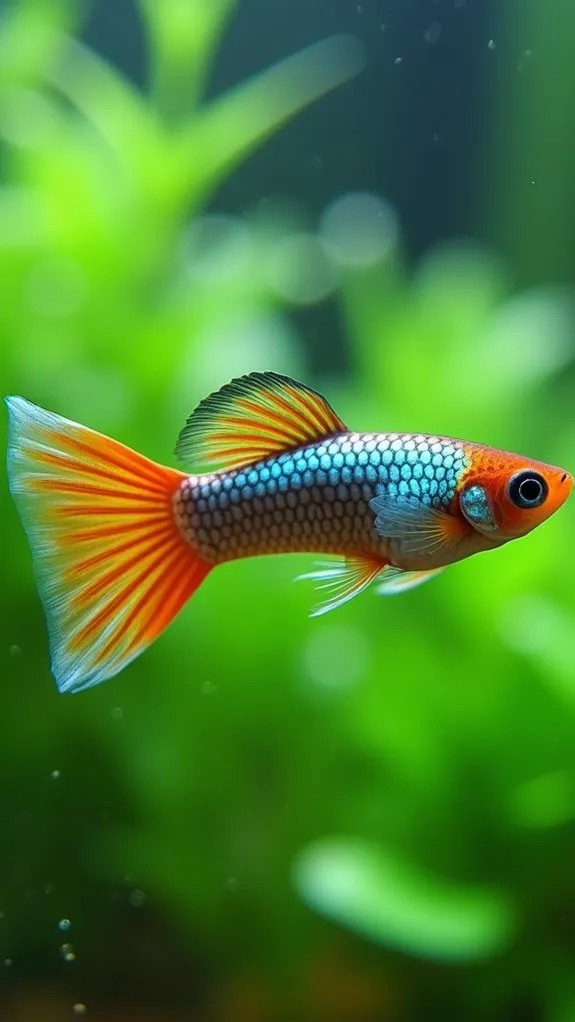
Among aquarium enthusiasts, guppies stand out as natural swimmers with fascinating social behaviors. You'll be amazed to watch these colorful little fish communicate through their graceful movements and vibrant displays, especially when they're forming their social hierarchies.
Like tiny underwater dancers, they'll create loose groups called shoals, which isn't just for show – it's actually a clever survival strategy that makes them appear larger to potential predators. A natural part of their behavior is that males display brightly to attract females within these groups. Monitoring your guppies for signs of erratic swimming could indicate potential swim bladder problems that need attention.
When you're keeping guppies, you'll want to pay attention to their swimming patterns, as these can tell you a lot about their health and happiness. Keeping water parameters stable is crucial for their well-being. If you notice your guppies swimming sideways or in circles, it might be time to check your water quality or tank conditions.
They're quite sensitive to their environment, and they'll let you know when something's not right. To keep your guppies swimming naturally, you'll want to maintain proper water temperatures between 68-78°F and provide plenty of hiding spots with plants and decorations.
Setting Up The Perfect Tank
Setting up the perfect tank starts with choosing the right location and equipment for your aquatic friends. You'll want to place your aquarium on a sturdy, flat surface away from windows and temperature-changing elements like heaters or AC units. This helps maintain consistent water quality and makes tank maintenance much easier in the long run.
Before you bring home your finned companions, you'll need to properly cycle your tank for a couple of weeks. During this time, don't worry if the water looks a bit cloudy – that's totally normal!
Just make sure you've got these essentials covered:
- A reliable filter and heater to maintain proper water conditions
- Substrate, plants, and decorations (all rinsed thoroughly)
- Water testing kits to monitor your tank's health
Remember to fill your tank slowly using a plate to prevent stirring up the gravel – it's like pouring coffee onto a spoon to avoid splashing! Adding pure ammonia during the cycling process will help establish beneficial bacteria that are vital for a stable aquatic environment.
Add your water conditioner to neutralize chlorine, and keep that thermometer handy. If you're planning on tropical fish, you'll want to maintain temperatures between 22-27°C, while cold-water fish prefer it a bit cooler.
Daily Care Requirements
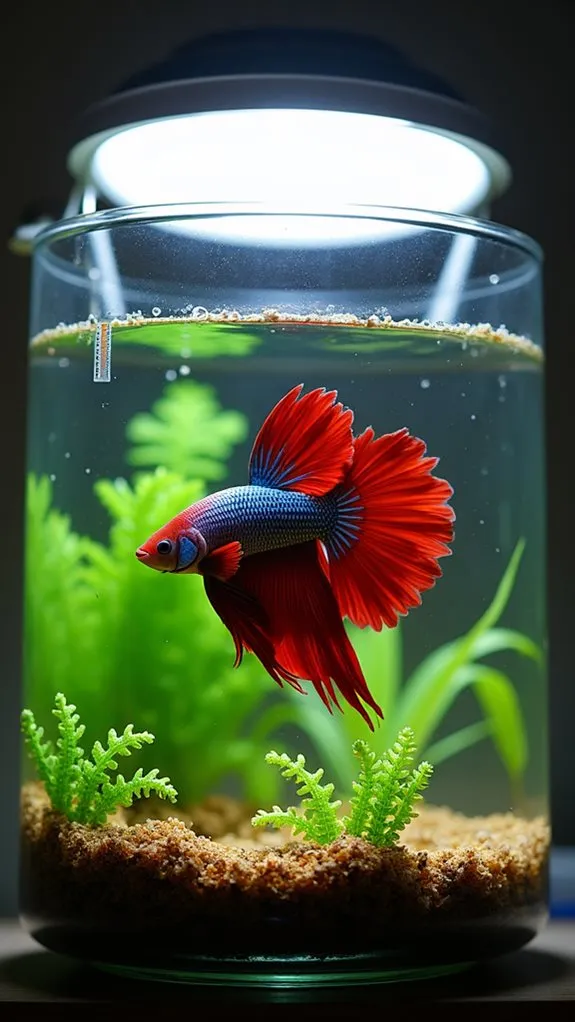
Maintaining your fish's daily care routine doesn't need to be complicated or time-consuming. With a few simple habits, you'll keep your aquatic friends healthy and happy without spending hours hovering over the tank.
Water quality is your top priority, and it's easier than you'd think to manage. You'll want to test the water weekly (think of it as your fish's version of a health checkup), and perform partial water changes every few weeks. Regular water changes help to dilute harmful chemicals and maintain a stable environment for your fish.
Don't worry – you won't need a chemistry degree to handle this! Just use a reliable testing kit and follow the instructions.
Your fish's dietary needs are pretty straightforward, too. Just like you wouldn't want to skip meals or overeat, your fish need balanced portions. Feed them small amounts that they can consume within a few minutes, and you'll avoid the dreaded "food cloud" floating around the tank.
If you're often away, an automatic feeder can be your best friend – it's like having a reliable fish-sitter on duty! Remember to vary their diet with different food types to keep them swimming happily and healthily.
Best Fish For Community Tanks
When you're setting up a community tank, you'll want to look for peaceful fish that'll get along swimmingly with their tank mates.
Species like neon tetras, cherry barbs, and guppies make perfect neighbors since they're naturally gentle and won't pick fights with other fish.
For the best success, you'll want to group similar-sized fish together, which is why combining peaceful schooling fish like tetras with calm bottom-dwellers like cory catfish works so well. Additionally, ensuring that these fish are housed in a minimum tank size of 10 gallons helps maintain a healthy environment for all inhabitants.
Peaceful Fish Live Together
A well-planned community tank can bring vibrant life and endless entertainment to your home aquarium. When you're choosing peaceful fish that'll live together harmoniously, schooling behavior and tank compatibility are your best friends. Fish like neon tetras, corydoras, and white cloud minnows thrive in groups, creating stunning displays as they swim together.
You'll want to keep these essential tips in mind for a successful community tank:
- Always keep similar-sized fish together to prevent bullying and stress – guppies, platies, and celestial pearl danios make perfect tankmates.
- Maintain groups of at least six fish of the same species, especially for schooling fish like tetras and danios.
- Include different swimming levels with bottom dwellers like cory catfish, mid-level swimmers like honey gouramis, and top-dwellers like mollies.
Don't forget that peaceful community fish aren't just easier to care for – they're also incredibly entertaining to watch! Additionally, selecting beginner-friendly species ensures a more successful and enjoyable fishkeeping experience.
You'll love how guppies dance through plants, tetras shimmer in the light, and corydoras playfully scoot across the bottom. With proper planning, you'll create a fascinating underwater community that's both beautiful and low-maintenance.
Easy Tank Mate Options
Building on the fundamentals of a peaceful community tank, choosing the right tank mates becomes your next exciting step. When you're considering fish compatibility, tank size plays an essential role in determining your options.
You'll find that small tanks around 10 gallons work beautifully with guppies, cherry barbs, or neon tetras – these little swimmers are like the friendly neighbors of the aquatic world!
For medium-sized tanks, you've got some fantastic choices. Platies and mollies are perfect roommates, bringing vibrant colors and easy-going personalities to your underwater community.
Don't forget about the industrious bristlenose plecos, who'll happily keep your tank clean while getting along with everyone else.
If you're working with a larger tank, you'll have even more options to explore. Peaceful Bolivian cichlids make wonderful community members, while schools of tetras and rasboras add life and movement to your aquatic paradise.
Just remember to match your fish's preferred water conditions – temperature and pH levels are like creating the perfect climate for your finned friends to thrive together harmoniously. Keeping an eye on water quality standards is essential for the health of your community tank.
Compatible Species By Size
Creating a harmonious community tank starts with understanding fish sizes and their compatibility. When you're planning your aquarium's community, fish size compatibility plays an essential role in maintaining peace and balance.
You'll want to take into account how different sized fish interact, as larger species might view smaller ones as snacks rather than neighbors!
Here's what you'll need to know about community tank dynamics based on size groups:
- Small fish (under 2 inches) like neon tetras and guppies make perfect starter community fish – they're peaceful, easy to care for, and love swimming in schools.
- Medium-sized fish (2-4 inches) such as platies and dwarf gouramis add wonderful variety without overwhelming smaller tank mates.
- Larger community fish (4-6 inches) like swordtails and rainbowfish need more space but can coexist beautifully with medium-sized species.
Common Beginner Fish Mistakes
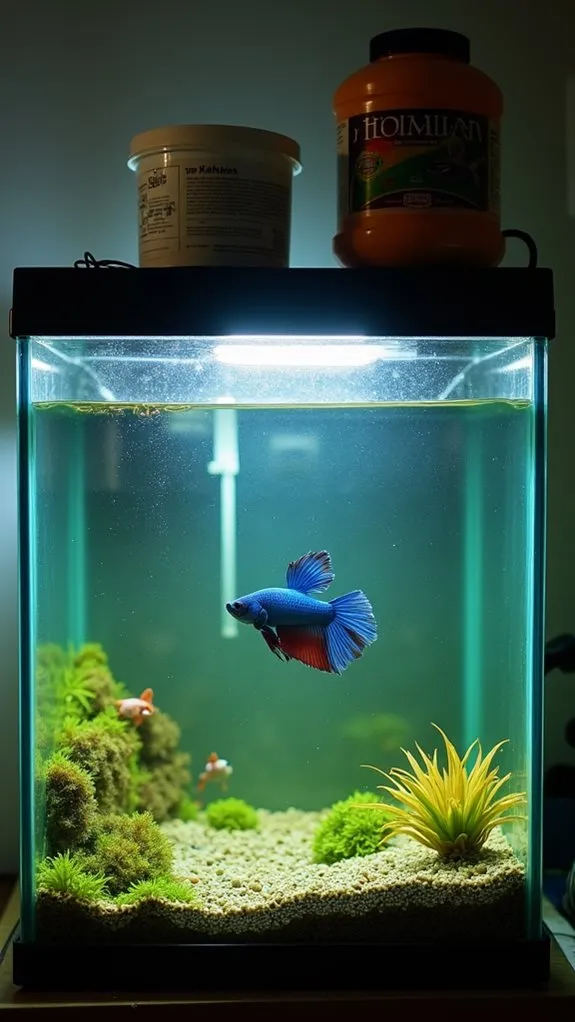
New fish owners' enthusiasm often leads to preventable mistakes that can jeopardize their aquarium's success. Among the most common mistakes is rushing to add fish before properly cycling the tank, which can lead to harmful ammonia buildup and stressed fish.
You'll want to take your time and let beneficial bacteria establish themselves before introducing any finned friends.
Understanding fish compatibility is essential for a peaceful aquarium community. You can't just pick fish based on their looks – you'll need to research their temperaments, adult sizes, and social needs.
That gorgeous angelfish might look harmless now, but it could become a bully to smaller tank mates later on!
Equipment quality matters more than you might think. While it's tempting to cut corners on filters and heaters, investing in reliable gear will save you headaches (and money) in the long run.
Don't forget about regular maintenance, either – consistent water testing and proper feeding are your best friends.
If you're feeling overwhelmed, remember that patience is your greatest ally. Taking things slow and steady will help you avoid the frustrating cycle of fish loss that many beginners face.
Essential Fish Health Tips
Keeping up with proper fish health requires attention to several key factors. Your aquatic friends need the right nutritional balance and consistent water management to thrive in their home. Just like you wouldn't want to eat the same meal every day, your fish need a varied diet that includes proteins, fats, and essential vitamins to stay healthy and active.
To keep your fish happy and healthy, follow these vital tips:
- Feed your fish small portions 1-2 times daily, making sure they can finish their meal within 5 minutes – it's better to underfeed than overfeed!
- Change 10-25% of the tank water regularly, and always check that the temperature stays between 68-78°F for most common fish species.
- Monitor water quality weekly using test kits to catch any problems before they affect your fish's health.
Remember to provide plenty of hiding spots for your finned friends, as this helps reduce stress. You'll also want to maintain proper protein levels – herbivores need 35-45%, while carnivores require 40-55%.
Think of yourself as your fish's personal chef and environmental manager, ensuring they've the perfect balance of nutrition and clean water.
Frequently Asked Questions
Can I Keep Different Types of Male Betta Fish Together?
You shouldn't keep male betta fish together, regardless of their type. Their aggressive behavior will lead to fighting and injury. If you want multiple bettas, you'll need separate tanks for each male.
How Long Do Easy-Care Aquarium Fish Typically Live?
You'll find most beginner fish like guppies, mollies, and platys live 3-5 years, while neon tetras and cory catfish reach 5-7 years. Fish longevity varies, with goldfish potentially living up to 30 years.
What Should I Do if My Fish Stops Eating?
First, check your water quality and monitor fish behavior changes. You'll want to try different feeding techniques, like varying food types. If problems persist, test water parameters and consult a fish veterinarian.
Are Certain Fish Colors More Hardy Than Others?
There's no scientific evidence that a fish's color affects its hardiness. You'll find hardy fish species in all colors, as their resilience depends on genetics, species characteristics, and care requirements rather than coloration.
Can Beginner-Friendly Fish Survive Power Outages Without Special Equipment?
You'll find that most beginner fish can survive short power outages, but you'll need to manage fish stress through temperature control and oxygen levels. Without special equipment, your fish's survival chances decrease considerably.
Final Thoughts
You've got plenty of great options for starting your fish-keeping journey. Whether you choose a beautiful betta, some playful guppies, or another beginner-friendly species, remember that success comes down to proper tank setup and consistent care. Don't forget to maintain water quality, feed appropriately, and watch for signs of illness. With these basics mastered, you'll be well on your way to becoming a confident fish keeper.

